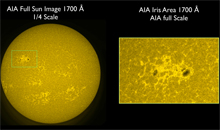Jul 26 2013
The Interface Region Imaging Spectrograph (IRIS) observatory, designed and built by Lockheed Martin for NASA, has produced its first images and spectra of a little understood region of the sun through which the energy that supports the Sun’s hot corona is transported.
 Solar Dynamics Observatory (SDO) full disk image on left and full resolution close-up of a solar active region (right). Both were generated using SDO's AIA instrument in 1700 wavelength. Credit: NASA/SDO/LMSAL/AIA/IRIS
Solar Dynamics Observatory (SDO) full disk image on left and full resolution close-up of a solar active region (right). Both were generated using SDO's AIA instrument in 1700 wavelength. Credit: NASA/SDO/LMSAL/AIA/IRIS
IRIS was launched on June 27, 2013, and the front door of the IRIS telescope was opened on July 17.
“The quality of images and spectra we are receiving from IRIS is amazing. This is just what we were hoping for,” said Dr. Alan Title, IRIS principal investigator and physicist at the Lockheed Martin Advanced Technology Center (ATC) Solar and Astrophysics Laboratory in Palo Alto, Calif. "There is much work ahead to understand what we’re seeing, but the quality of the data will enable us to do that."
The IRIS mission has long-term implications for understanding the genesis of solar storms. By tracing the flow of energy and plasma through the interface region – between the solar surface and the solar corona – where most of the sun’s ultraviolet emissions are generated, IRIS data will allow scientists to study and model a region of the sun that has yet to reveal its secrets.
“With IRIS, we now have a unique opportunity to provide significant missing pieces in our understanding of energy transport on the sun,” said Dr. Alan Title, IRIS principal investigator and physicist at the Lockheed Martin Advanced Technology Center (ATC) Solar and Astrophysics Laboratory in Palo Alto, Calif. “The complex processes and enormous contrasts of density, temperature and magnetic field within this interface region require instrument and modeling capabilities that are now finally within reach.”
The evolution of IRIS from concept to space-based solar observatory was remarkably rapid. The contract was awarded to the Lockheed Martin-led IRIS team on June 23, 2009. Four years and four days later, IRIS was in orbit. Just 20 days after launch, engineers in the IRIS Mission Operations Center at NASA's Ames Research Center, Moffett Field, Calif., downlinked the initial images.
“The IRIS mission has been, from inception, an enormous international collaborative development effort,” said Title. “Our IRIS team was formed to design the mission and prepare the initial proposal. We have worked together seamlessly ever since.”
The IRIS Observatory was designed and the mission managed by the Lockheed Martin Solar and Astrophysics Laboratory of the Advanced Technology Center in Palo Alto, with contributions from LM Civil Space. The IRIS instrument was integrated to the spacecraft, and observatory testing was performed by an integrated team of engineers from the ATC and Civil Space at the LM Space Systems Sunnyvale facility. The Harvard-Smithsonian Center for Astrophysics built the telescope.
In parallel with payload development, there was international collaboration in calculating enormous numerical simulations of the interface region, mostly using models from the University of Oslo. These simulations are key to interpreting the IRIS observations. The University of Oslo and Lockheed Martin also worked together in creating tools for execution of the science mission, enabling scientists to plan observations on the complex and flexible IRIS instrument more easily. Kongsberg Satellite Service under an ESA PRODEX contract with the Norwegian Space Centre captures IRIS data with their antennas in Svalbard, inside the Arctic Circle, in northern Norway.
NASA’s Ames Research Center, Moffett Field, Calif., is responsible for mission operations and the ground data system. The Ames Pleiades supercomputer was used to carry out many of the numerical simulations. IRIS science data is managed by the Joint Science Operations Center of the Solar Dynamics Observatory (SDO) – run by Stanford and Lockheed Martin – where scientists can use the same set of tools to access data from IRIS, SDO and Hinode instruments. Montana State University faculty and students assisted in the design of the spectrograph and are involved in IRIS science operations and data analysis. NASA’s Kennedy Space Center acquired the Orbital Sciences Corp. Pegasus launch vehicle and managed the Vandenberg launch. NASA’s Goddard Space Flight Center in Greenbelt, Md., oversees the Small Explorers program.
Lockheed Martin Space Systems Company, a major operating unit of Lockheed Martin Corporation, designs, develops, tests, manufactures and operates a full spectrum of advanced-technology systems for national security and military, civil government and commercial customers. Chief products include human space flight systems; a full range of remote sensing, navigation, meteorological and communications satellites and instruments; space observatories and interplanetary spacecraft; laser radar; ballistic missiles; missile defense systems; and nanotechnology research and development.